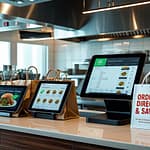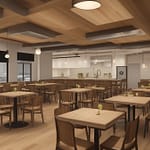Key Takeaways:
- Understand your restaurant’s revenue cycle to anticipate potential cash flow issues.
- Implement effective bookkeeping practices to stay updated on your financial situation.
- Regularly review and adjust menu pricing to maintain profitability and manage cash flow.
- Explore different financing options such as loans or investors to shore up cash reserves.
- Minimize overhead costs where possible, including negotiating with suppliers for better deals.
Cash Flow Chaos? Here’s How to Regain Control
Fix cash flow issues before they hurt you
Running a restaurant is a balancing act. Between managing inventory, staffing, customer satisfaction, and day-to-day operations, keeping your finances stable often becomes challenging. One critical element many restaurant owners overlook is effective cash flow management. Even successful establishments can fall victim to cash flow issues, making it essential to understand and master your financial health.
In this guide, we’ll explore practical steps to help you regain control of your restaurant’s cash flow, ensuring your business thrives rather than merely survives.
Why Cash Flow Management Matters in Restaurants
Restaurants operate on thin profit margins, making cash flow management critical. Without proper control over your cash flow, you risk running short on funds to pay suppliers, maintain payroll, or invest in essential equipment. Even thriving restaurants can face cash crunches due to seasonal fluctuations, unexpected expenses, or inefficient financial practices.
Effective cash flow management allows your business to:
- Pay bills promptly and maintain good supplier relationships.
- Ensure timely payroll, keeping staff morale and retention high.
- Invest strategically in marketing, equipment upgrades, and expansion.
- Maintain stability during slow periods or unexpected downturns.
Identify the Causes of Your Cash Flow Problems
To solve cash flow issues, you must first pinpoint where your restaurant’s financial troubles originate. Common culprits in the restaurant industry include:
Poor Inventory Management
Excessive or poorly tracked inventory ties up cash that could be better used elsewhere. Spoilage, theft, or inaccurate ordering can quickly drain your resources without delivering any return.
High Labor Costs
Labor is typically one of a restaurant’s largest expenses. Mismanaged scheduling, overstaffing, or overtime costs can severely impact your cash flow.
Inefficient Accounts Receivable and Payable Practices
Late payments from catering or event clients, delayed billing, or failure to collect outstanding debts can create significant cash shortfalls. Conversely, paying bills too early without considering cash availability can strain your finances.
Unexpected Expenses
Unexpected repairs, equipment failures, or sudden regulatory fines can deplete cash reserves quickly, leaving your restaurant vulnerable.
Actionable Restaurant Finance Tips to Optimize Cash Flow
Once you’ve identified your restaurant’s primary cash flow issues, it’s time to take corrective action. Here are practical steps to regain control:
1. Streamline Inventory Management
Effective inventory management is critical to maintaining healthy cash flow:
- Conduct regular inventory audits to identify waste and inefficiencies.
- Implement inventory management software to track ingredient usage accurately.
- Negotiate favorable payment terms with suppliers to align purchases with actual sales volumes.
- Establish par levels and reorder points to minimize spoilage and overstocking.
For example, a busy casual dining restaurant reduced inventory holding costs by 20% simply by adopting software that tracked sales trends and optimized ordering schedules. This adjustment freed up significant cash resources for other business needs.
2. Control Labor Costs Effectively
Labor expenses can quickly spiral out of control if not carefully monitored:
- Forecast staffing needs based on sales data and historical trends to prevent overstaffing.
- Train managers on proper scheduling practices to reduce overtime and labor inefficiencies.
- Use scheduling software to track employee hours accurately and avoid costly payroll mistakes.
- Monitor peak and off-peak hours to optimize staffing levels accordingly.
Consider a local café that implemented employee scheduling software. By precisely aligning staff schedules to peak customer traffic hours, they reduced labor costs by 15%, greatly improving cash flow.
3. Improve Accounts Receivable and Payable Management
Balancing receivables and payables effectively can significantly improve cash flow:
- Invoice promptly and clearly, with defined payment terms and due dates.
- Follow up regularly on unpaid invoices to collect outstanding debts promptly.
- Consider offering incentives, such as small discounts, for early payment to improve cash flow.
- Negotiate extended payment terms with suppliers, allowing more time to manage cash effectively.
One catering-focused restaurant improved its cash flow dramatically by implementing strict invoicing and collection policies. By invoicing immediately after events and offering small early-payment discounts, they reduced their accounts receivable timeframe from 45 days to less than 20 days on average.
4. Set Aside Cash Reserves for Emergencies
Unforeseen expenses can derail your restaurant unless you plan ahead:
- Regularly contribute to an emergency cash reserve fund to cover unexpected costs.
- Incorporate contingency planning into your annual budget.
- Assess and prioritize potential risks, such as equipment failure or supply chain disruptions, and plan accordingly.
For instance, a pizza chain owner began allocating 5% of monthly profits into an emergency fund. When faced with unexpected equipment breakdowns, the restaurant was able to draw from this fund without disrupting daily operations or impacting their cash flow negatively.
Leverage Technology and Financial Tools
Today’s digital tools and financial services can simplify cash flow management and provide real-time insights into your financial health:
- Accounting software like QuickBooks or Xero can automate invoicing, bill payments, and financial reporting, providing clarity on your cash position.
- Cloud-based POS systems offer detailed sales analytics, helping you forecast cash flow and adjust operations proactively.
- Budgeting and forecasting software assists in planning and predicting your restaurant’s financial future more accurately.
Take the case of a small fine-dining establishment that adopted cloud-based accounting and POS integration. This switch provided a real-time snapshot of their cash flow, allowing managers to make informed decisions swiftly and adapt to changing market conditions effectively.
Regularly Monitor and Adjust Your Cash Flow Management Strategy
Cash flow management isn’t a set-and-forget process. Regular monitoring and adjustment are essential:
- Review cash flow statements weekly or monthly, identifying trends and making necessary changes.
- Analyze seasonal fluctuations and plan accordingly to smooth cash flow peaks and valleys.
- Seek professional financial advice periodically to ensure your strategies remain effective.
For example, a popular seafood restaurant reviewed its cash flow monthly and identified significant dips during winter months. By proactively adjusting inventory, staffing, and marketing strategies in advance each year, they minimized financial stress and maintained consistent profitability year-round.
Conclusion: Regain Control and Thrive
Cash flow chaos doesn’t have to be your restaurant’s normal. By understanding the root causes of your cash flow problems and implementing practical, actionable solutions, you can regain financial stability and set your restaurant up for long-term success.
Prioritize effective inventory and labor management, establish clear financial practices, leverage technology, and regularly monitor your financial health. With these strategies, you’ll transform cash flow management from a source of stress into a powerful tool that drives your restaurant’s growth and prosperity.






Comments
Be the first to comment on this article.